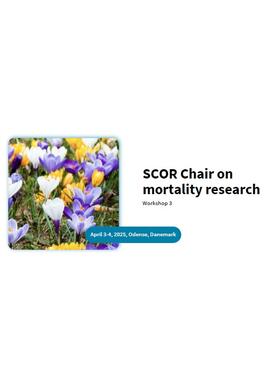SCOR Chair on Mortality Research | Workshop
Held in Denmark on April 3 & 4, 2025, this workshop marks the halfway point of the project.

This third workshop of the SCOR Chair on Mortality Research was held from April 3-4 at the University of Southern Denmark in Odense, marking the halfway point of the project. Ten invited speakers presented their ongoing research across three thematic areas:
- Multiple causes of death analysis
- Mortality modelling and forecasting
- Health and healthcare utilization
Multiple Causes of Death Analysis
Presentations revealed that, instead of capturing all conditions present at the end of life, multiple causes of death data typically reflect diseases related to the primary cause, with notable variation in how different conditions are reported. Significant changes over time were also observed in how causes are recorded on death certificates, particularly in whether they are more frequently reported as underlying or contributing causes. Finally, while there is a general longevity extension observed in low-mortality populations, this extension is not uniformly reflected across all causes of death. Some causes show a marked mortality postponement toward older ages, whereas others display resistance to such delay.
Mortality Modelling and Forecasting
Four innovative models or model applications were introduced to better understand and forecast mortality patterns and trends. A model-based recursive partitioning approach was used to classify households and neighborhoods into groups with similar demographic and socioeconomic profiles, shedding light on mortality inequalities. Enhanced modelling also demonstrated that the rate of mortality increase with age has remained stable across time and populations. Regarding forecasting, it was shown that traditional machine learning models outperformed transformer-based models in short-term mortality predictions. Additionally, harvesting models proved valuable in capturing population immunity profiles during pandemics and quantifying their magnitude.
Health and Healthcare Utilization
Presentations showed that health trajectories vary significantly across socioeconomic groups. Individuals from lower socioeconomic backgrounds transition more rapidly into poor health compared to their higher-status counterparts. Moreover, healthcare utilization is influenced not only by disease profiles but also by cognitive function, underscoring the complexity of healthcare needs.
All Presentations
"Triangle Simplex Plot for Representing Multiple Cause of Death Dynamics"
- Author: Elizabet Ukolova"Quantifying Harvesting: Estimating and forecasting the effect of mortality shocks on population dynamics"
- Author: Trifon I. Missov"Understanding end-of-life multimorbidity: An analysis of Multiple Causes of Death in Denmark"
- Authors: Cosmo Strozza, Elizaveta Ukolova & Marie-Pier Bergeron-Boucher
